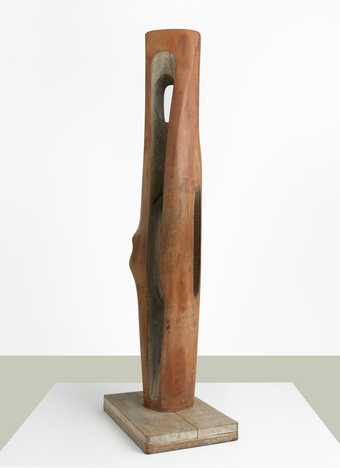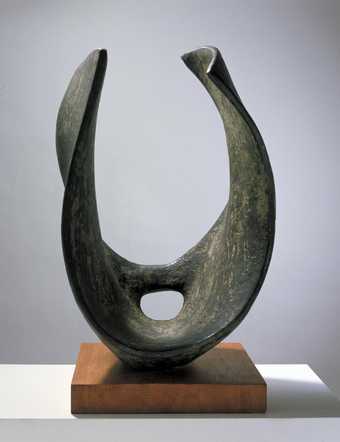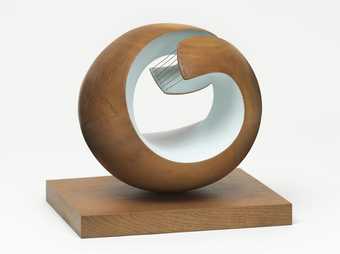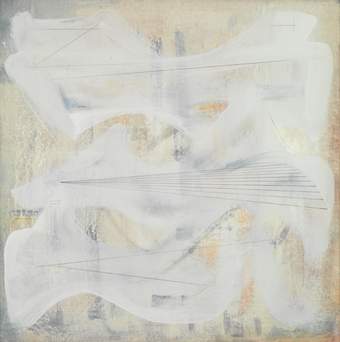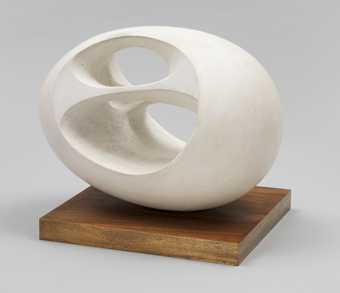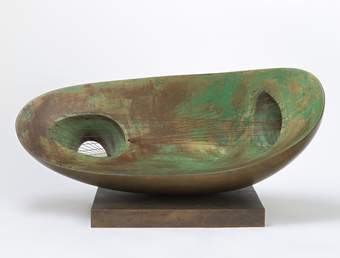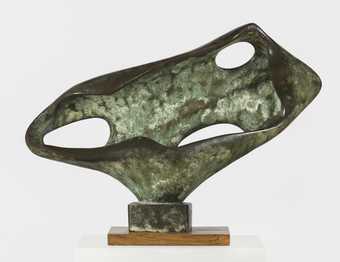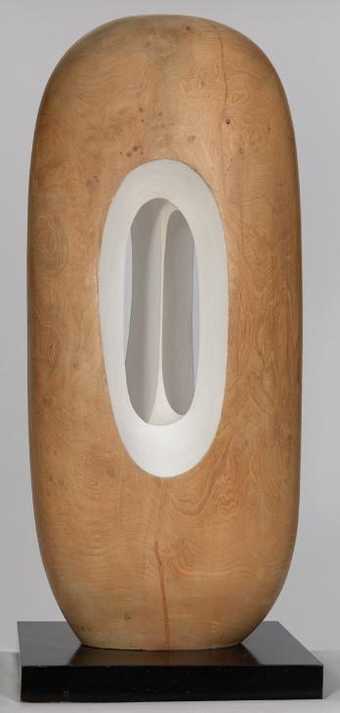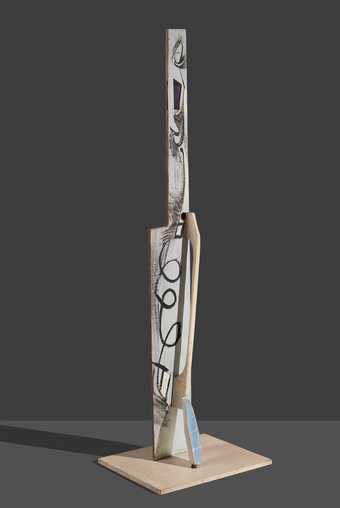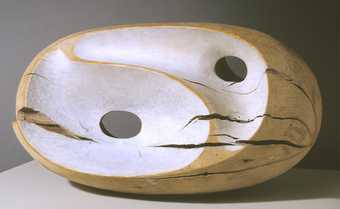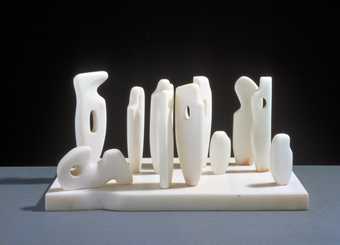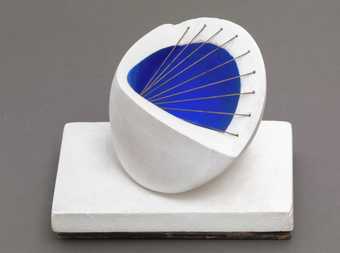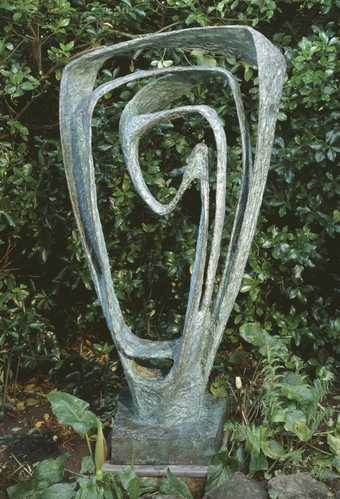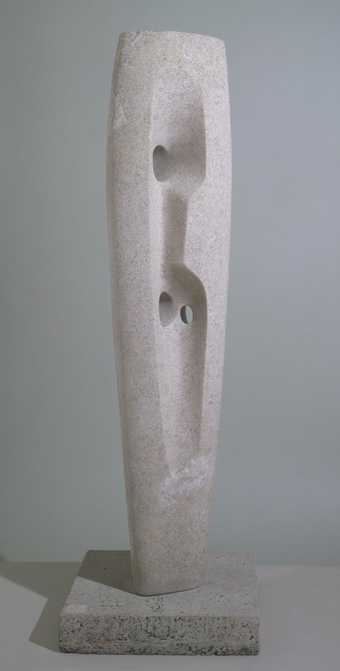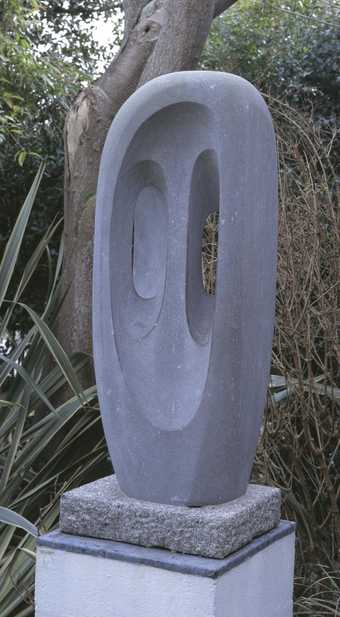
In Barbara Hepworth Museum and Sculpture Garden
- Artist
- Dame Barbara Hepworth 1903–1975
- Medium
- Wood
- Dimensions
- Object: 320 × 680 × 290 mm
- Collection
- Tate
- Acquisition
- Accepted by HM Government in lieu of inheritance tax and allocated to Tate 2005, accessioned 2006
- Reference
- T12284
Catalogue entry
Landscape Sculpture 1944
L00944
BH 127
Broadleaf elm and strings 270 x 654 x 270 (10 5/8 x 25 3/4 x 10 5/8) on veneered base 36 x 355 x 277 (1 3/8 x 14 x 10 11/16)
On loan from the artist's estate to the Barbara Hepworth Museum, St Ives
Provenance:
...; Mr & Mrs S. Kaye; Gimpel Fils and artist jointly, c.1962; the artist 1972
Exhibited:
Barbara Hepworth: Sculpture and Drawings, Lefevre Gallery, Oct. 1946 (13)
Barbara Hepworth: Sculpture and Drawings, Wakefield City Art Gallery, May-July 1951, York City Art Gallery, July-Aug., Manchester City Art Gallery, Sept.-Oct. (22)
? Design and Sculpture by Consagra, Hoflehner, Mullen, Perez, Piper, Ramous and Hepworth, MacRoberts and Tunnard, Feb.-March 1961 (12, as 'Landscape 1944')
Er?ffnungs-Ausstellung, Gimpel & Hanover Galerie, Zurich, Nov. 1962-Jan. 1963 (26, repr.)
Barbara Hepworth: Sculpture and Drawings, Gimpel & Hanover Galerie, Zurich, Nov. 1963-Jan. 1964 (3a)
Profile III: Englische Kunst der Gegenwart, St?dtische Kunstgalerie, Bochum, April-June 1964 (59, repr.)
Barbara Hepworth: Sculpture and Drawings, Gimpel Fils, June 1964 (3a)
St. Ives: Twenty Five Years of Painting, Sculpture and Pottery, Tate Gallery, Feb.-March 1985 (57, repr. p.166)
St Ives, Hyogo Prefectural Museum of Modern Art, April-May 1989, Museum of Modern Art, Kamatura, May-June, Setagaya Art Museum, July-Aug. (42, repr. in col. p.67)
Literature:
E.H. Ramsden, Sculpture: Theme and Variations, 1953, p.42, pl.92
J.P. Hodin, Barbara Hepworth, 1961, p.165, no.127, repr.
Reproduced:
Barbara Hepworth, 'Approach to Sculpture', Studio, vol.132, no.643, Oct. 1946, p.98 (as 'Wood Sculpture with Strings. 1945')
Herbert Read, Barbara Hepworth: Carvings and Drawings, 1952, pls.73a-d
Barbara Hepworth: Retrospective Exhibition 1927-54, exh. cat., Whitechapel Art Gallery, 1954, pl.K
A.M. Hammacher, Barbara Hepworth, 1968, rev. ed. 1987, p.92, pl.65
Landscape Sculpture characterises Hepworth's attempts in the mid 1940s to synthesise constructive forms and techniques with the theme of landscape. As such, it anticipates one of the principal aspects of her post-war sculpture and reveals her desire to revise her practice in the aftermath of the war.
The work was carved from elm, reflecting the shortage of material other than locally grown timber. The main form is pierced at each end, the holes narrowing towards the back. It is traversed by nine strings, which have discoloured. These emerge from holes along the edge of the right hand opening, converge on a single hole on the left, pass down through the wood and back up across the left hand aperture to a further sequence of small holes, from where they cross back to the right hand side, through the opening and terminate in a single hole at the back. The knotted ends of the strings are all visible. Though the sculpture appears flat in photographs, the form curves towards the front as if pulled by the strings and the back has an angular 'elbow' near the right hand end. At the time of this work, Hepworth identified three sizes of sculpture: 'the small intimate "hand sculpture" ... the "arm" sculpture ... [and] the large sculpture, the size of the human figure' (Hepworth 1946, p.100). That this work belongs to the second category is reflected in this elbow form. The heart of the wood runs the length of the sculpture, passing approximately from the left hand hole to the point on the right at which the strings converge. Though it has a slightly dry appearance, the timber has no significant splits. Filler has been applied to a knot in the left hand opening and around the strings. The back of the sculpture has been bleached on the right hand end by the sun but a group of dark markings towards the left end of the is a natural discolouration. The earliest published photographs of the work (Hepworth 1946) show that its original wooden base was as long as the sculpture; the shorter one on which it now sits was probably added by the artist when she reacquired the work in the 1960s.
After her relocation to Cornwall at the outbreak of war, Hepworth increasingly discussed her work in relation to the landscape. She longed to see a large version of Sculpture with Colour (Deep Blue and Red) (Tate Gallery T03133), the first wartime piece, sited outside and a number of the carvings after 1943, such as Pelagos (Tate Gallery T00699), allude specifically to the environment. Of the war years Hepworth later recalled: 'It was during this time that I gradually discovered the remarkable pagan landscape ... which still has a deep effect on me, developing all my ideas about the relationship of the human figure in the landscape' (Read 1952, section 4). At the same time, she also sought to relate her earlier work to a similar source. Discussing a photograph of her Single Form, 1937-8 (BH 102, Leeds City Art Galleries, repr. Read 1952, pl.52), taken against young birch trees, she said in 1943: 'I took this photo myself ... because when I conceived Single Form it was born of this particular sort of landscape - all my sculpture comes out of landscape' (letter to E.H. Ramsden, 28 April [1943], TGA 9310). Landscape Sculpture was one of several works which the artist photographed herself in her Carbis Bay garden in the 1940s (Hodin 1961, pl.127).
E.H. Ramsden, who was especially close to Hepworth in the 1940s, was able to associate the work with a specific place. She described it as 'a transcription of the felt "pull" existing between two hills, in Uny Lelant, near the Cornish coast' (Ramsden 1953, p.42). Uny Lelant is close to Chy an Kerris, the house in Headland Road, Carbis Bay, which Hepworth shared with Ben Nicholson and where the sculpture was carved. Ramsden's account echoed Hepworth's own explanation of her use of stringing in many works of the 1940s. 'The strings', the artist wrote, 'were the tension I felt between myself and the sea, the wind or the hills' (Read 1952, section 4). This conceit was later employed by the artist John Wells when discussing his Relief Construction, 1940 (Tate Gallery T01759), which, he said, 'express[es] (unconsciously perhaps) my deep awareness of the living tensions of the environment of the [Scilly] Islands' (letter to the Tate Gallery, 18 Dec. 1973). Wells was a member of the small group of constructivists exhibiting in Britain during the war and, later, a prominent member of the circle of artists in St Ives. Landscape Sculpture follows his relief in its use of lateral strings diverging from round or elliptical forms. This was a characteristic of a number of Wells's pieces of the 1940s and derived from his knowledge, largely in reproduction, of modernist paintings and constructions of the 1930s. A comparable use of linear elements may be seen in Hans Erni's work and, put to a different use, in the landscape-based paintings of John Tunnard. After the war, the association of abstract form with landscape became a characteristic not only of Hepworth's work but also of the group of artists in St Ives centred on her and Nicholson.
Landscape Sculpture was one of several earlier works which Hepworth cast in bronze in the late 1950s and early 1960s; other examples include Oval Sculpture, 1943, cast in 1958 (Tate Gallery T00953) and Single Form (Eikon), 1937-8, cast 1963 (Tate Gallery T00697). Cast in an edition of seven, the artist's copy (7/7) is in the collection of the Tate Gallery.
Chris Stephens
March 1998
Explore
- abstraction(8,615)
-
- from recognisable sources(3,634)
-
- landscape(1,191)
- non-representational(6,161)
-
- irregular forms(2,007)
- universal concepts(6,387)
-
- environment / nature(315)
- UK cities, towns and villages(12,725)
-
- Lelant(6)
- Cornwall(1,034)
- England(19,202)
- England, South West(3,507)
- England, Southern(8,982)
- abstract concepts(119)
You might like
-
Dame Barbara Hepworth Figure (Nanjizal)
1958 -
Dame Barbara Hepworth Curved Form (Trevalgan)
1956 -
Dame Barbara Hepworth Pelagos
1946 -
Dame Barbara Hepworth Forms (West Penwith)
1958 -
Dame Barbara Hepworth Oval Sculpture (No. 2)
1943, cast 1958 -
Dame Barbara Hepworth Landscape Sculpture
1944, cast 1961 -
Dame Barbara Hepworth Sea Form (Porthmeor)
1958 -
Dame Barbara Hepworth Hollow Form with White
1965 -
Peter Lanyon Tall Country and Seashore
1951 -
Dame Barbara Hepworth Tides I
1946 -
Dame Barbara Hepworth Group I (Concourse) February 4 1951
1951 -
Dame Barbara Hepworth Sculpture with Colour (Deep Blue and Red)
1940 -
Dame Barbara Hepworth Garden Sculpture (Model for Meridian)
1958 -
Dame Barbara Hepworth Image
1951–2 -
Dame Barbara Hepworth Stone Sculpture (Fugue II)
1956

